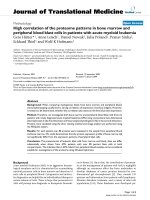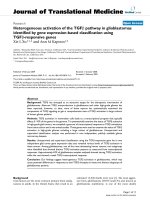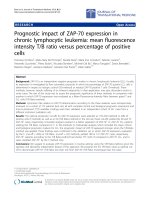Báo cáo hóa học: " The origin of the red emission in n-ZnO nanotubes/p-GaN white light emitting diodes" pdf
Bạn đang xem bản rút gọn của tài liệu. Xem và tải ngay bản đầy đủ của tài liệu tại đây (1.64 MB, 7 trang )
NANO EXPRESS Open Access
The origin of the red emission in n-ZnO
nanotubes/p-GaN white light emitting diodes
N H Alvi
*
, Kamran ul Hasan, Omer Nur, Magnus Willander
Abstract
In this article, the electroluminescence (EL) spectra of zinc oxide (ZnO) nanotubes/p-GaN light emitting diodes
(LEDs) annealed in different ambients (argon, air, oxygen, and nitrogen) hav e been investigated. The ZnO
nanotubes by aqueous chemical growth (ACG) technique on p-GaN substrates were obtained. The as-grown ZnO
nanotubes were annealed in different ambients at 600°C for 30 min. The EL investigations showed that air, oxygen,
and nitrogen annealing ambients have strongly affected the deep level emission bands in ZnO. It was concluded
from the EL investigation that more than one deep level defect is involved in the red emission appearing between
620 and 750 nm and that the red emission in ZnO can be attributed to oxygen interstitials (O
i
) appearing in the
range from 620 nm (1.99 eV) to 690 nm (1.79 eV), and to oxygen vacancies (V
o
) appearing in the range from 690
nm (1.79 eV) to 750 nm (1.65 eV). The annealing ambients, especially the nitrogen ambient, were also found to
greatly influence the color-rendering properties and increase the CRI of the as - grown LEDs from 87 to 96.
Introduction
Zinc oxide (ZnO) is a direct wide band gap (3.37 eV)
semiconductor. In rece nt years, it has a ttracted the
attention of the research community for a variety of
practical applications due to its excellent properties
combined with the facility of growing it in the nanos-
tructure form.
At present, ZnO is considered to be a very attractive
material because it combines semiconducting and piezo-
electric properties and in addition it is transparent, bio-
compatible, and bio-safe. These unique properties of
ZnO makes it as a promising candidate for the next
generation of visible and ultra-violet (UV) light-emitting
diodes (LEDs) and lasing devices. The visible emission
results because ZnO possesses deep level emission
(DLE) bands and emit all the colors in the visible region
with good color-rend ering properties [1-8]. It is impor-
tant to understand the origin of the emissions re lated to
deep level defects in ZnO for the development of optoe-
lectronic devices with high efficiency.
A number of studies on the optical properties of ZnO
nanostructures have suggested that, within the DLE,
the green (approximately 500 nm) and red (approxi-
mately 600 nm) emissions have originated from oxygen
vacancies (V
o
) and zinc interstitial (Zn
i
)[9-14].Other
authors have reported that the green emission can be
attributed to both oxygen and zinc vacancies [15,16]. The
violet-blue and blue emissions were attributed to zinc
interstitial (Zn
i
) and Zinc vacancies (V
zn
), respectively, in
the DLE [17-19]. The yellow emission in hydrothermally
grown nanorods was attributed to the presence of OH
groups on the surface [9]. The formation energy and
energy levels of different defects within the DLE have
been experimentally studied and calculated by other
authors [9,20]. However, the origins of different defect
emissions are still not fully unde rstood , and the hypoth-
eses that have been proposed to explain the different
defect emissions (violet, blue, green, yellow, orange-red,
and red) have been controversial [9,10,21,22]. Therefore,
still a considerable interest is being shown in investigat-
ing the defect emissions in ZnO in general and, ZnO
nanostructures in particular, because of their great
potential for optical applications.
The ZnO nanotubes are the best c andidates for white
LEDs among all of the known oxide semiconductors,
and they can be easily grown via chemical and other
physical vapor-phase a pproaches as well [6]. The small
footprintandthelargesurfacearea-to-volumeratio
make the ZnO nanotubes a better candidate for hetero-
junction white LEDs as compared to thin films. The lat-
tice mismatch can be compensated in view of the
* Correspondence:
Department of Science and Technology (ITN) Campus Norrköping, Linköping
University, 60174 Norrköping, Sweden
Alvi et al. Nanoscale Research Letters 2011, 6:130
/>© 2011 Alvi et al; licensee Springer. This is an Open Access article distributed under the terms of the Creative Commons Attribution
License (http://cr eativecommons.org/licenses/by/2.0), which permits unrestricted use, distribution, and reproduction in a ny medium,
provided the original work is properly cited.
favorable stress/strain values observed for ZnO nano-
tubes as compared to thin films. A notable advantage of
nanotube-based LEDs is that each nanotube can act as a
wave guide, minimizing the side scattering of light, thus
enhancing light emission and extraction efficiency [23].
The GaN has close lattice mismatch with ZnO, and the
close lattice match is the main factor that can influence
the optical and electrical properties of heterojunctions.
Only a few studie s focusing on n-ZnO nanotubes, on p-
GaN, and on white light emitting diodes (LEDs) are
available in the literature [24-26].
Many researchers have investigated the DLEs in ZnO.
The optical properties of chemically synthesized ZnO
nanorods, post-growth annealed in temperatures ranging
from 200 to 800°C, have been studied using photolumines-
cence measurements. In our investigation, the as-grown
nanotubes were annealed at 600°C as this temperature was
foundtobeveryeffectiveinmodifyingtheDLEs
[9,10,21,27,28]. Previously, the authors have investigated
the effect of post-growth annealing treatment on the elec-
troluminescence (EL) of n-ZnO nanorods/p-GaN LEDs.
The annealing ambients have the same effect on EL of
LEDs, but ZnO nanotube-based LEDs were found to have
approximately twice the EL intensity as compared to that
of ZnO nanorod-based LEDs [29].
ZnO nanostructures grown by low temperature (<100°
C) growth techniques such as aqueous chemical growth
(ACG) have low crystal quality with lattice and surface
defects. The post-growth anneal ing is an effective tool to
enhance and control the crystallinity and optical proper-
ties of ZnO nanostructures [21]. In this article, the EL
spectra of LEDs fabricated using the as-grown as well as
the ZnO nanotubes annealed in argon, air, oxygen, and
nitrogen ambients have been investigated. The results
showed that oxygen and nitrogen ambients are very
effective on modifying the deep level defects, and that the
red emission in ZnO was attributed to the superpositio n
of emissions related to oxygen interstitial and oxygen
vacancies in ZnO. T he post-growth annealing ambient
also strongly influences the color-rendering properties of
ZnO nanotubes. We have commercially purchased mag-
nesium-doped p-type GaN with film thickness of 4 μm
on sphire substrates from TDI Inc. USA. It has hole con-
centration of approximately 4 × 10
17
cm
-3
.
To obtain the ZnO nanotubes, first, the ZnO nanor-
ods were grown on the p-GaN substrates using the low
temperature ACG method, and then these nanorods
were chemically etched to get nanotubes. There are
many chemical growth methods employed for growing
ZnO nanorods. The most common method is the one
described by Vayssieres et al. [30]. By using this method,
the ZnO nanorods were grown on p-GaN substrate. To
improve the quality of the grown ZnO nanorods,
the said method was combined with the substrate
preparation technique developed by Greene et al. [31].
The grown ZnO nanorods on the p-GaN substrates
were etched by placing the samples in 5-7.5 molar KCl
(Potassium chloride) solution for 5-10 h at 95°C.
The samples were then annealed in argon, air, oxygen,
and nitrogen ambients at 600°C for 30 min. Pt/Ni/Au
alloy was used to form ohmic contact with the p-GaN
substrate. The thicknesses of the Pt, Ni, and the Au
layers were 20, 30, and 80 nm, respectively. The samples
were then annealed at 350°C for 1 min in flowing argon
atmosphere. This alloy gives a minimum specific contact
resistance of 5.1 × 10
-4
Ω cm
-2
[32]. An insulating
photo-resist layer was then spun coated on the ZnO
NTs to fill the gaps between the nanotubes with a view
to isolate electrical contacts on the ZnO NTs to prevent
them from reaching the p-type substrate, thereby help-
ing to prevent the carrier cross talk among the n ano-
tubes. To form the top contacts, the tip of the ZnO
NTs were exposed using plasma ion-etching technique
after the deposition of the insulating photo-resist layer.
Non-alloyed Pt/Al metal system was used to form the
ohmic contacts to the ZnO NTs. The thicknesses of the
Pt and the Al layers were 50 and 60 nm, respectively.
This contact gives a minimum specific contact resis-
tance of 1.2 × 10
-5
Ω cm
-2
[28]. The diameter of the top
contact was about 0.58 mm.
Results and discussions
Figure 1a,b shows the images of the top of the ZnO
nanotubes before and after annealing, respective ly. The
figure shows clearly the morphology and size distribu-
tion of the as-grown ZnO nanotubes. Hexagonal, well-
aligned, vertical ZnO nanotubes were obtained on the
p-GaN substrate. The ZnO NTs grown had a uniaxial
orientation of 〈0001〉 with an epitaxial orientation
with respect to the p-GaN substrate, forming n-ZnO-
(NTs)/p-GaN p-n heterojunctions. From the SEM
images, the mean inner and outer diameters of the as-
grown ZnO nanotubes in this study were found to be
approximately 360 and 400 nm, respectively. Figure 1c
shows the current-voltage, I-V, curves of the n-ZnO
NTs/ p-GaN LEDs developed in this study. All the LEDs
have the same I-V curves. The I-V curves clearly show a
rectifying behavior of the LED as expected with a turn
on threshold voltage of about 4 V. This indicates clearly
that both metal/GaN and metal/n-ZnO interfaces have
formed good ohmic contacts . Figure 1d shows the sche-
matic illustration of the fabricated LEDs.
Figure 2 shows the EL spectra of the as-grown and
annealed LEDs. All the EL measurements were taken
under forward bias of 25 V. The EL spectra consist of
violet, violet-blue, orange, orange-red, and red p eaks.
The violet and violet-blue peaks are centered approxi-
mately at 400 nm (3.1 eV) and 452 nm (2.74 eV),
Alvi et al. Nanoscale Research Letters 2011, 6:130
/>Page 2 of 7
respectively. The broad green, orange, orange-red,
and red peaks are centered approximately at 536 nm
(2.31 eV), 597 nm (2.07 eV), 618 nm (2.00 eV), and 705
nm (1.75 eV), respectively. The EL emission in the ultra-
violet (UV) region was not detected here since the
authorswereinterestedonlyinthevisibleemissions;
therefore, the lower EL detector limit was set to 400 nm.
The EL intensity of the samples annealed in argon is
low compared to the as-grown and all other samples
annealed in dif ferent ambients. The ZnO na notubes
having low growth temperature (<100°C) possess many
intrinsic defects, such as oxygen vacancy (V
o
), zinc
vacancy (V
zn
), interstitial zinc (Zn
i
), interstitial oxygen
(O
i
), etc., and these defects are responsible for the
DLEs. These defects are reduced after annealing at high
temperature (600°C). Such activation or passivation of
intrinsic defects would greatly enhance the crystal’s deep
level defect structure leading to the modification of
luminescence spectra efficiency of the LEDs [16]. This
argument is also confirmed by the EL spectra obtained
for ZnO nanotubes annealed in argon (see Figure 2).
The EL intensities of the violet (400 nm) and violet-blue
(452 nm) of all the annealed samples are decreased as
compared with the as-grown samples. In the literature,
itwasreportedthattheviolet emission from undoped
ZnO nanorods i s related to Zinc interstitial (Zn
i
)[22].
The violet peak is centered at 3.1 eV (400 nm), and this
agrees well with the transition energy from Zn
i
level to
the valence band in ZnO (approximately 3.1 eV). The
violet-blue peak was centered at 2.74 eV (452 nm) for
all the EL measurements in different ambients. It is
attributed to recombina tion between the Zn
i
energy
level to the V
Zn
energy level, and approximately is in
agreement with the transition energy from Zn
i
energy
level to V
Zn
energy level (approximately 2.84 eV). The re
is a difference of 0.11 eV. This diff erence maybe is due
to the effect of GaN substrate, as GaN also emits blue
light. There are no shifts in violet and violet-blue peaks
after annealing in different ambients. The violet and vio-
let-blue emissions decreased after annealing the as-
grown ZnO nanotubes i n different ambients. The violet
and violet-blue are the high energy emissions in the
(a) (b)
-8 -6 -4 -2 0 2 4 6 8 10
0.0
0.2
0.4
0.6
0.8
1.0
1.2
Current (mA)
Voltage (V)
(c)
(d)
Figure 1 SEM image of ZnO nanotubes on p-GaN substrate. (a) before annealing, (b) after annealing, (c) typical I-V characteristics for the
fabricated LEDs, and (d) The schematic illustration of the fabricated LEDs.
Alvi et al. Nanoscale Research Letters 2011, 6:130
/>Page 3 of 7
visible region, and the annealing affects the deep level
defects that are responsible for low energy emissions
from the green-to-red region in the visible spectra (see
in Figure 2). It increases the transition recombination
rate for the deep level defects that are responsible for
the green-to-red emissions. Therefore, the EL intensities
of the D LEs (the green to red) are increased, while
those of the violet and violet-blue emissions are
decreased after annealing in different ambients. Only for
the case of the argon ambient, all the defects are modi-
fied, and owing to this, the El intensities of all the emis-
sions decreased after annealing.
The broad green peak, centered at 536 nm (2.31 eV)
in the EL spectra of the as-grown ZnO nanotube-based
LEDs and LEDs based on annealed ZnO nanotubes in
argon ambient, is attributed to oxygen vacancy (V
o
). It
is believed that this phenomenon is due to band transi-
tion from zinc interstitial (Zn
i
) to oxygen vacancy (V
o
)
defect levels in ZnO [22]. This has been explained by
the full potential linear muffin-tin orbital method, which
posits that the position of the V
o
level is located
approximately at 2.47 eV below the conduct ion band,
and the position of the Zn
i
level is theoretically located
at 0.22 eV below the conduction band. Therefore, it is
expected that the band transition from Zn
i
to V
o
level is
approximately 2.25 eV [22]. This agrees well with the
green peak that is centered approximately at 2.31 eV.
The orange-red peaks are centered at 597 nm (2.07
eV) and 618 nm (2.00 eV) for th e samples annealed in
air and oxygen, respectiv ely. These emissions are attrib -
uted to oxygen interstitials O
i
, and believed to be due to
band transition from zinc interstitial (Zn
i
)tooxygen
interstitial (O
i
) defect levels in ZnO [22]. The position
of the O
i
level is located approximately at 2.28 eV below
the conduction band, and it is expected that the band
transition from Zn
i
to O
i
level is approximately 2.06 eV
[22]. This agrees well with the orange-red peaks that are
centered approximately at 2.00 and 2.07 eV.
The EL spectra of ZnO nanotubes annealed in oxygen
and air ambients are nearly similar. The EL intensity of
the sample annealed i n oxygen is higher compared to
that of the sample annealed in air. Its means that air
and oxygen produce the same defects, but the ratio of
these defects is more in the case of oxygen. As the
orange-red emission is attributed to oxygen interstitials
O
i
[22], the annealing in oxygen ambient inc reases the
amount of oxyge n-related O
i
defects; therefore, the
orange-red emission dominates the EL spectra.
The red emission centered at 705 nm (1.75 eV) can be
attributed to oxygen vacancies (V
o
). For the ZnO nano-
tubes annealed in nitrogen ambient, the following oxy-
gen desorption may occur;
ZnO V Zn 1 2O
oZn 2
/
The zinc vacancies are f illed with zinc during the
annealing of the ZnO nanotubes in the nitrogen ambi-
ent. The majority of defects are oxygen vacancies (V
o
)
300 400 500 600 700 800 900
0
5000
10000
15000
20000
25000
30000
35000
40000
45000
50000
400 nm
452 nm
536 nm
597 nm
618 nm
705 nm
EL intensity (a.u.)
Wavelen
g
th
(
nm
)
as grown
annealed in argon
annealed in air
annealed in oxygen
annealed in nitrogen
Figure 2 Electroluminescence spectra of the LEDs at an injection current of 3 mA for the as grown and annealed ZnO NTs in different
ambients under forward bias of 25 V and it shows the shift in emission peak after annealing in different ambient.
Alvi et al. Nanoscale Research Letters 2011, 6:130
/>Page 4 of 7
that are created by the evaporation of oxygen [21]. The
red emission centering at 706 nm (1.75 eV) may be
attributed to the t ransition from oxygen vacancy (V
o
)
level to top of the valance band in ZnO. Using full-
potential linear muffin-tin orbital method, the calculated
energy level of the V
o
in ZnO is 1.62 eV below the con-
duction band [20]. Hence, the energy interval from the
V
o
energy level to the top of the valence band is
approximately 1.75 eV. It agrees well with that observed
for the red emission centered at 1.75 eV.
By comparing the EL spectra of samples annealed in
oxygen and nitrogen, it can be conc luded that t he total
red emission ranging from 620 nm (1.99 eV) to 750 nm
(1.65 eV) is the combination of emissions related to O
i
and V
o
defects. The EL spectra of the samples annealed
in oxygen show that after annealing, the red emission is
enhanced in the range from 620 nm (1.99 eV) to 690
nm (1.79 eV) when compared to the as-gro wn samples,
and the EL spectra of the samples annealed in nitrogen
ambient show that, after annealing, the red emission is
enhanced in the range from 690 nm (1.79 eV) to 750
nm (1.65 eV). The EL intensities of the green, yellow,
orange, and the red emission (from 620 to 690 nm) are
decreased, but the EL intensity o f the red emission
(from 690 to 750 nm) has increased significantly as
compared with the as-grown ZnO nanotubes. Therefore,
it is clear that the red emissions from 620 to 690 nm
and from 690 to 750 nm have different origins. The red
emission in the range of 620 nm (1.99 eV) to 690 nm
(1.79 eV) can be attributed to O
i
, and that in the range
of 690 nm (1.79 eV) to 750 nm (1.65 eV) can be attribu-
ted to V
o
.
Figure 3a,b,c,d,e shows the CIE 1931 color space chro-
maticity diagram in the (x, y) coordinates system. The
chromaticity coordinates are (0.3559, 0.3970), (0.3557,
3934), (0.4300, 0.4348), (0.4800, 0.4486), and (0.4602,
0.3963) with correlated color temperatures (CCTs) of
4802, 4795, 3353, 2713, and 2583 K for the as-grown
ZnO nanotubes, annealed in argon , air, oxygen, and
nitrogen, in the forward bias, respectively. The chroma-
ticity coordinates are very close to the Planckian locus
which is the trace of the chromaticity coordinates of a
blackbody. The colors around the Planckian locus can
be regarded as white. It is clear that the fabricated LEDs
are in fact the white LEDs.
Figure 4 shows the schematic band diagram of the
DLE emissions in ZnO, based on the full-potential linear
muffin-tin orbital method and the reported data.
Figure 3 The CIE 1931 x, y chromaticity space of ZnO nanotubes, for (a) as grown, (b) annealed in argon, (c) annealed in air, (d) annealed
in oxygen, (e) annealed in nitrogen, and (f) all together.
Alvi et al. Nanoscale Research Letters 2011, 6:130
/>Page 5 of 7
In summary, the origin of red emission in chemically
obtained ZnO nanotubes has been investigated by EL
spectra. The as-grown samples were annealed in different
ambient (argon, air, oxygen, and nitrogen). It was observed
that the post-growth annealing in nitrogen and oxygen
ambients strongly affe cted the green, yellow, orange, and
red emissions of ZnO nanotubes. The EL intensities of the
green, the yellow, the orange, and the red emissions were
gradually increased after annealing in air, oxygen ambi-
ents, and decrease in argon ambient. However, in nitrogen
ambient, t he EL emission of the red peak in the range of
690–750 nm was increased, and in the range of 620-690
nm, it was decreased as compared with the as-grown sam-
ples. It was found that more than one deep level defect are
involved in producing the red emission in ZnO.
Abbreviations
ACG: aqueous chemical growth; DLE: deep level emission; EL:
electroluminescence; LEDs: light emitting diodes; UV: ultra-violet; ZnO: zinc
oxide.
Acknowledgements
The financial support from the Advanced Functional Materials (AFM) project
at Linköping University is highly appreciated
Authors’ contributions
All authors contributed equally and read and approved the final manuscript.
Competing interests
The authors declare that they have no competing interests.
Received: 22 October 2010 Accepted: 10 February 2011
Published: 10 February 2011
References
1. Gong Y, Andelman T, Neumark G, O’Brien S, Kuskovsky I: Origin of defect-
related green emission from ZnO nanoparticles: effect of surface
modification. Nanoscale Res Lett 2007, 2:297-302.
2. Bian J, Liu W, Liang H, Hu L, Sun J, Luo Y, Du G: Room temperature
electroluminescence from the n-ZnMgO/ZnO/p-ZnMgO heterojunction
device grown by ultrasonic spray pyrolysis. Chem Phys Lett 2006, 430:183-187.
3. Alivov YI, Look DC, Ataev BM, Chukichev MV, Mamedov VV, Zinenko VI,
Agafonov YA, Pustovit AN: Fabrication of ZnO-based metal-insulator-
semiconductor diodes by ion implantation. Solid-State Electron 2004,
48:2343-2346.
4. Look DC: Recent advances in ZnO materials and devices. Mater Sci Eng B
2001, 80:383-387.
5. Yang LL, Zhao QX, Willander M, Yang JH, Ivanov I: Annealing effects on
optical properties of low temperature grown ZnO nanorod arrays. J Appl
Phys 2009, 105:053503-053507.
6. Willander M, Nur O, Zhao QX, Yang LL, Lorenz M, Cao BQ, Zúñiga Pérez J,
Czekalla C, Zimmermann G, Grundmann M, Bakin A, Behrends A, Al-
Suleiman M, El-Shaer A, Che Mofor A, Postels B, Waag A, Boukos N,
Travlos A, Kwack HS, Guinard J, Le Si Dang D: Zinc oxide nanorod based
photonic devices: recent progress in growth, light emitting diodes and
lasers. Nanotechnology 2009, 20:332001.
7. Wang ZL: Nanostructures of zinc oxide. Mater Today 2004, 7:26-33.
8. Klingshirn C: ZnO: From basics towards applications. Phys Status Solidi (b)
2007, 244:3027-3073.
9. Djurisic AB, Leung YH, Tam KH, Hsu YF, Ding L, Ge WK, Zhong YC,
Wong KS, Chan WK, Tam HL, Cheah KW, Kwok WM, Phillips D: Defect
emissions in ZnO nanostructures. Nanotechnology 2007, 18:095702.
10. Tam KH, Cheung CK, Leung YH, Djurišić AB, Ling CC, Beling CD, Fung S,
Kwok WM, Chan WK, Phillips DL, Ding L, Ge WK: Defects in ZnO nanorods
prepared by a hydrothermal method. JPhysChemB2006, 110:20865-20871.
11. Jeong SH, Kim BS, Lee BT: Photoluminescence dependence of ZnO films
grown on Si(100) by radio-frequency magnetron sputtering on the
growth ambient. Appl Phys Lett 2003, 82:2625-2627.
12. Shan FK, Liu GX, Lee WJ, Shin BC: The role of oxygen vacancies in
epitaxial-deposited ZnO thin films. J Appl Phys 2007, 101:053106-053108.
13. Djurisic AB, Leung YH, Tam KH, Ding L, Ge WK, Chen HY, Gwo S: Green,
yellow, and orange defect emission from ZnO nanostructures: Influence
of excitation wavelength. Appl Phys Lett 2006, 88:103107-103103.
Figure 4 Schematic band diagram of the DLE emissions in ZnO based on the full potential linear muffin-tin orbital method and the
reported data as described in references [9-20,22]. Also oxygen vacancies situated 1.65 eV below the conduction band are denoted to be
contributing to the red emission.
Alvi et al. Nanoscale Research Letters 2011, 6:130
/>Page 6 of 7
14. Carcia PF, McLean RS, Reilly MH, Nunes JG: Transparent ZnO thin-film
transistor fabricated by rf magnetron sputtering. Appl Phys Lett 2003,
82:1117-1119.
15. Zhao QX, Klason P, Willander M, Zhong HM, Lu W, Yang JH: Deep-level
emissions influenced by O and Zn implantations in ZnO. Appl Phys Lett
2005, 87:211912-211913.
16. Yamauchi S, Goto Y, Hariu T: Photoluminescence studies of undoped and
nitrogen-doped ZnO layers grown by plasma-assisted epitaxy. J Cryst
Growth 2004, 260:1-6.
17. Cao B, Cai W, Zeng H: Temperature-dependent shifts of three emission
bands for ZnO nanoneedle arrays. Appl Phys Lett 2006, 88:161101-161103.
18. Zeng H, Li Z, Cai W, Liu P: Strong localization effect in temperature
dependence of violet-blue emission from ZnO nanoshells. J Appl Phys
2007, 102:104307-104304.
19. Wei XQ, Man BY, Liu M, Xue CS, Zhuang HZ, Yang C: Blue luminescent
centers and microstructural evaluation by XPS and Raman in ZnO thin
films annealed in vacuum, N2 and O2. Physica B 2007, 388:145-152.
20. Lin B, Fu Z, Jia Y: Green luminescent center in undoped zinc oxide films
deposited on silicon substrates. Appl Phys Lett 2001, 79:943-945.
21. Quang LH, Chua SJ, Ping Loh K, Fitzgerald E: The effect of post-annealing
treatment on photoluminescence of ZnO nanorods prepared by
hydrothermal synthesis. J Cryst Growth 2006, 287:157-161.
22. Ahn CH, Kim YY, Kim DC, Mohanta SK, Cho HK: A comparative analysis of
deep level emission in ZnO layers deposited by various methods. J Appl
Phys 2009, 105:089902-089901.
23. Lai E, Kim W, Yang P: Vertical nanowire array-based light emitting diodes.
Nano Res 2008, 1:123-128.
24. Yuen C, Yu SF, Lau SP, Rusli , Chen TP: Fabrication of n-ZnO:Al/p-SiC(4H)
heterojunction light-emitting diodes by filtered cathodic vacuum arc
technique. Appl Phys Lett 2005, 86:241111-241113.
25. Young Joon H, Jong-Myeong J, Miyoung K, Seong-Ran J, Kyung Ho P, Gyu-
Chul Y: Structural and optical characteristics of GaN/ZnO coaxial
nanotube heterostructure arrays for light-emitting device applications.
New Journal of Physics 2009, 11:125021.
26. Sadaf J, Israr M, Kishwar S, Nur O, Willander M: White electroluminescence
using ZnO nanotubes/GaN heterostructure light-emitting diode.
Nanoscale Res Lett 2010, 5:957-960.
27. Leung YH, Djurisic AB, Liu ZT, Li D, Xie MH, Chan WK: Defect
photoluminescence of ZnO nanorods synthesized by chemical methods.
J Phys Chem Solids 2008, 69:353-357.
28. Kim HK, Kim KK, Park SJ, Seong TY, Adesida I: Formation of low resistance
nonalloyed Al/Pt ohmic contacts on n-type ZnO epitaxial layer. J Appl
Phys 2003, 94:4225-4227.
29. Vayssieres L, Keis K, Lindquist SE, Hagfeldt A: Purpose-built anisotropic
metal oxide material: 3D highly oriented microrod array of ZnO. J Phys
Chem B 2001, 105:3350-3352.
30. Alvi NH, Willander M, Nur O: The effect of the post-growth annealing on
the electroluminescence properties of n-ZnO nanorods/p-GaN light
emitting diodes. Superlattices and Microstructures 2010, 47:754-761.
31. Greene LE, Law M, Tan DH, Montano M, Goldberger J, Somorjai G, Yang P:
General route to vertical ZnO nanowire arrays using textured ZnO
seeds. Nano Lett 2005, 5:1231-1236.
32. Jang JS, Chang IS, Kim HK, Seong TY, Lee S, Park SJ: Low-resistance Pt/Ni/
Au ohmic contacts to p-type GaN. Appl Phys Lett 1999, 74:70-72.
doi:10.1186/1556-276X-6-130
Cite this article as: Alvi et al.: The origin of the red emission in n-ZnO
nanotubes/p-GaN white light emitting diodes. Nanoscale Research Letters
2011 6:130.
Submit your manuscript to a
journal and benefi t from:
7 Convenient online submission
7 Rigorous peer review
7 Immediate publication on acceptance
7 Open access: articles freely available online
7 High visibility within the fi eld
7 Retaining the copyright to your article
Submit your next manuscript at 7 springeropen.com
Alvi et al. Nanoscale Research Letters 2011, 6:130
/>Page 7 of 7









